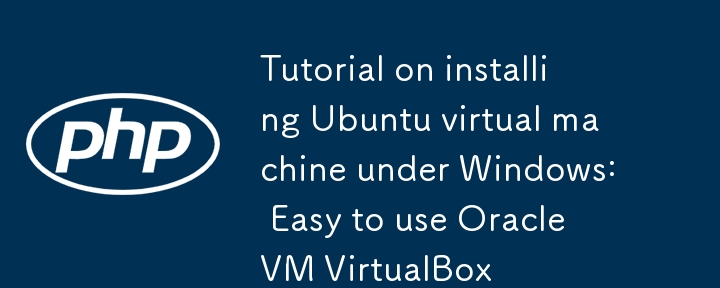

Install Ubuntu virtual machine under Windows. Choose to enable OracleVMVirtualBox to install the Ubuntu virtual machine.
1. Download and install OracleVMVirtualBox: Visit the official website of OracleVMVirtualBox (), download the installation package for Windows, and install it according to the instructions of the installation wizard.
2. Download the Ubuntu ISO image: Visit the Ubuntu official website () vm virtual machine to install linux, select the appropriate Ubuntu version ISO image file from the download page, and select the Desktop version as needed.
3. Create a new virtual machine: Open OracleVMVirtualBox, click the "New" button, and create a new virtual machine according to the wizard. During the process, specify the name, type (Linux), version (corresponding to Ubuntu version), memory size, etc. of the virtual machine.
4. Assign a virtual optical drive: When selecting the hard disk type, select "Create virtual optical drive" and follow the default settings. After that, on the Assign Virtual Optical Drive page, select "Dynamic Allocation" and determine the size of the virtual optical drive.


5. Install the Ubuntu operating system: Select the newly created virtual machine and click the "Settings" button to enter the settings page. In the settings page, select the "Storage" tab, click the c drive icon under "Empty"vm virtual machine installation linux, and select "Virtual CD File" at the "CD Icon" on the right, And navigate to the Ubuntu ISO image file you downloaded. Click "OK" to save the settings.
6. Start the virtual machine: Select the newly created virtual machine and click the "Start" button to start the virtual machine. At this point, the virtual machine will load the Ubuntu ISO image file.
7. Install Ubuntu: When the virtual machine starts, you will see the Ubuntu installation interface. Select "InstallUbuntu" and install according to the wizard. You can choose installation options, keyboard layout, partitions, and more.
8. Complete the installation: After completing the installation process, you will be prompted to restart the virtual machine. After restarting, you can log in to the Ubuntu operating system.
expansion:
1. After installing the new Ubuntu system, the following are some common tools and software that can provide a better user experience and functionality:
1. Update and upgrade tools: After installation, first ensure that the system is up to date. You can use the following commands to update and upgrade your system:

sudoaptupdate
This command is used to update the package list. It detects the package management system's repository and downloads the latest package information. It does not install or upgrade packages, it just updates the list of available packages.
sudoaptupgrade
This command is used to upgrade installed software packages. It updates existing packages to the latest available versions.
2. Network tools: Ubuntu has some basic network tools installed by default, but you may need additional tools for network debugging, management and monitoring. Some common online tools include:
wget: Command line download tool.
curl: used to send HTTP requests in the command line.

net-tools: Provides network diagnosis and configuration tools, such as ifconfig, netstat, etc.
traceroute: used to trace the path of network packets.
You can install this tool using the following command:
sudoaptinstallwgetcurlnet-toolstraceroute
3. Install the GNU tool chain and other necessary development tools and run the following command:
sudoaptinstallbuild-essential
4. Code reconstruction tools Cmake and make install embedded linux for training on linux operation and maintenance best practices. Run the following commands
sudoaptinstallcmakemake
2. Data transfer between the virtual machine and the host machine (shared folders, shared pasteboard, drag and drop) requires the installation of enhanced functions. If the prompt is as follows:

You need to install it automatically as follows:
1. Install dependent libraries
Open a terminal window in Ubuntu and make sure your system is updated. After that, install the dependent libraries required to compile the kernel module. Run the following command:
sudoaptupdate
sudoaptinstallbuild-essentialdkmslinux-headers-$(uname-r)
2. Execute the improved function installation program: Return to the Ubuntu virtual machine, open a terminal window, and switch to the mounting directory of the hard disk. Run the following command:
cd/media//VBox*
3. Run the enhanced functionality installation script: Run the following command to execute the enhanced functionality installation script:
sudo./VBoxLinuxAdditions.run
4. Complete installation and restart: Wait for the feature enhancement installation process to complete. After the installation is complete, restart the Ubuntu virtual machine for the improvements to take effect. You can restart by running the following command:
sudoreboot
After that, you can happily drag and drop files and copy and paste text between the host and the virtual machine.
The above is the detailed content of Tutorial on installing Ubuntu virtual machine under Windows: Easy to use Oracle VM VirtualBox. For more information, please follow other related articles on the PHP Chinese website!




